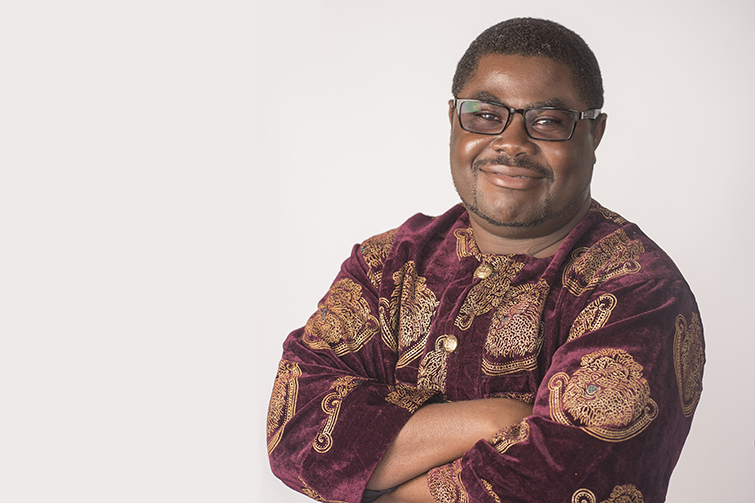26 August 2020
|
Story Andre Damons
|
Photo Sonia Small (Kaleidoscope Studios)
 Prof Abdon Atangana, Academic Head: Institute for Groundwater Studies, and Prof Dumitru Baleanu, from Çankaya University, in Ankara, Turkey, developed differential operators that could be used to model real-world problems arising in many fields of science, mathematics, technology, and engineering.
Prof Abdon Atangana, Academic Head: Institute for Groundwater Studies, and Prof Dumitru Baleanu, from Çankaya University, in Ankara, Turkey, developed differential operators that could be used to model real-world problems arising in many fields of science, mathematics, technology, and engineering.
The mathematical operators developed by a professor from the University of the Free State (UFS) and a colleague from Çankaya University, Ankara in Turkey, that could be used to model real-world problems arising in many fields of science, mathematics, technology, and engineering, are growing at a remarkable rate in these fields and have inspired an explosion of new research in fractional calculus.
Prof Abdon Atangana, Academic Head:
Institute for Groundwater Studies at the UFS, and
Prof Dumitru Baleanu from
Çankaya University developed their differential operators in 2016 when existing operators failed to accurately depict some physical problems. According to Prof Atangana, it took him one week of continuous thinking to develop a new fractional operator that could be used to model real-world problems arising in many fields of science, technology, and engineering.
Published papers are growing each year
According to a recently published article in the Alexandria Engineering Journal, titled
A bibliometric analysis of Atangana-Baleanu operators in fractional calculus, the Atangana-Baleanu operators has been cited in 351 published and peer-reviewed research papers since the first paper was published in 2016. The number of papers published each year is growing exponentially at a very high rate of 80,25%, showing a healthy and thriving field of research. In 2019, 156 papers were published on the topic and a further 95 papers have been published in the first three months of 2020.
Prof Atangana says it is a joy to see that the name of an African mathematician is attached to operators used in many fields of science, technology, and engineering.
“It is a very big joy, as one day an African child will say ‘I am proud to be African’, as these theories were developed by a black African youngster. A big joy to see that, for the first time ever, a black mathematician is added in the list of highly cited mathematicians. A big joy to know that I became the world’s youngest highly-cited mathematician, although this was not celebrated either by my work country or my university.”
“A big joy to see that only after four years of extremely hard work in a foreign land, I became editor of more than 20 top-tier journals of applied mathematics and mathematics; in some, I am the first African to be selected as editor. For me, it is a first step in the decolonisation of science; an indication that Africans can contribute and influence the world of mathematics,” says Prof Atangana.
New weapons into applied mathematics
To extend the limitations of the new concept, Prof Atangana provided new fractional differential operators called Atangana-Baleanu fractional derivatives. The Atangana-Baleanu fractional derivatives brought new weapons into applied mathematics to model complex real-world problems more accurately, because the derivatives have the following properties:
• The derivatives have at the same time Markovian and non-Markovian properties, while the well-known Riemann-Liouville derivative is just Markovian and the Caputo-Fabrizio derivative is non-Markovian.
• The derivative waiting time is at the same time power law, stretched exponential, and Brownian motion, while the Riemann-Liouville derivative is only power law and the Caputo-Fabrizio is only exponential decay.
• The derivative mean square displacement is a crossover from usual diffusion to sub-diffusion, while Riemann-Liouville is just power law and scale-invariant. This means the Atangana-Baleanu fractional derivative is able to describe real-world problems with different scales, or problems that change their properties during time and space – for instance, the spread of cancer, the flow of water within heterogeneous aquifers, movement of pollution within fractured aquifers, and many others. This crossover behaviour is observed in many empirical systems.
• The derivative probability distribution is at the same time Gaussian and non-Gaussian and can cross over from Gaussian to non-Gaussian without a steady state. This means that the Atangana-Baleanu fractional derivative is at the same time deterministic and stochastic, while the Riemann-Liouville is only deterministic. So, for instance, with this crossover, the Atangana-Baleanu fractional derivative is able to describe physical or biological phenomena such as a heart attack, the physiological progression from life to death, structural failure in an airplane, and many other physical occurrences of sudden change, with no steady state.
Research being done in developing countries
According to the article in the Alexandria Engineering Journal, papers published on Atangana-Baleanu operators were most commonly written by researchers from Mexico (36,9%), Saudi Arabia (14,6%), and India (9,2%). Although some countries contribute more papers than others, there is a lot of collaboration among co-authors across the world. “What is impressive is that research is being done in developing countries, demonstrating the global reach of these concepts into regions outside of wealthy countries. The exponential growth of papers and the wide representation of researchers from different countries show that research using Atangana-Baleanu operators is a diverse and flourishing discipline,” according to the article.